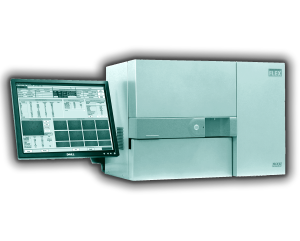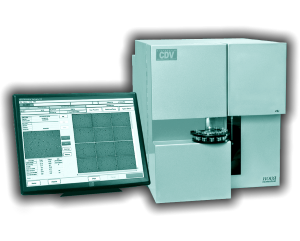New equipment solutions for the control and management of the culture process.
This article questions the influence of environmental factors on the processes of cell culture, a brief review of modern instrumental solutions for the control parameters of the culture medium. It is shown that the use of biotechnology analyzers allows for a more informative to study the processes of cultivation of microorganisms (mammalian cells, etc.).
Introduction
The most important purpose of technology in the design and operation of separating the fermentation of any biotechnological production is to ensure the most favorable conditions for crop growth, increase the yield of the desired product. This applies both to maintain the desired process temperature level of pH, and the composition and properties of the culture medium. The composition of the culture media should to the greatest extent meet the needs of the producer strain. The cultivation process task nepreryvnodejstvujushchego technologist reduced, ultimately, to maintain a constant concentration of essential nutrients (and oxygen) during operation of the industrial fermenter and metered introduction acid / alkali for pH-statirovaniya. More complex problems arise in the production of metabolites when during batch culture processes, the composition of the environment surrounding the cells of the producer strain, should be changed depending on the culture growth phase, its condition, and activity level. This fact makes it difficult to transfer this type of production a continuous mode of operation, and when a batch mode requires the staff of permanent monitoring and process control.
To solve these problems the present stage of development of industrial biotechnology requires reliable rapid methods for the quantitative study of the properties of living cells as a target product producer, as well as the concentration of nutrients and metabolites. In recent years, developed and introduced new instrumental solutions for the full express-control culture and nutritious angry. A relatively new class of such devices are biotech analyzer, by which to obtain information about the concentration of nutrients and metabolites in culture medium online. The principle of operation of such analyzers is based on biosensor technology, the use of which provides accurate, reproducible results within 1-2 minutes.
Review of the main factors of the culture medium and their role in the cultivation process (insert)
Consider these factors and management practices in more detail.
The composition and concentration of nutrient metabolism define producer cells. Depending on as such substances process type can act, glucose, sucrose, lactose, xylose, starch, cellulose, ethanol and the like. The composition of the nutrients is determined at the stage of the composition of the nutrient medium, and the concentration can be maintained or changed during fermentation, depending on method.
When cultured in a batch process fermenter once the entire volume of the nutrient medium and making the seed. The cultivation of microorganisms is carried out under optimum conditions for a certain time, after which the process is stopped, emptied and the contents of the fermenter isolating the desired product. crop growth stage includes: a lag phase, exponential phase, the phase of slowing growth, stationary phase, the phase of the withering away.
Widely used intermittent fed-batch cultivation. There is also a space-culturing the refill when the volume part of the bioreactor is withdrawn from time to time by adding an equivalent volume of medium (semi-continuous cultivation).
In a continuous process the nutrient medium is continuously fed to the fermenter (Bioreactor) which provide optimum conditions for microbial growth, and from the fermenter (Bioreactor) as follows continuously the culture liquid with microorganisms. In continuous processes bioobject maintained in exponential growth phase. At the same time there is a balance between the increase in biomass due to cell division and diminution as a result of dilution with fresh medium.
Products of metabolism (such as lactate or ammonia) and inhibitors of biochemical reactions slow down and, consequently, the whole fermentation process. Such substances should be derived from the fermentation medium. For this purpose, in the present moment it can be used a number of tooling solutions, such as a rotary filter. (Based on the rotary filter while rotating sieving techniques. It can be inserted directly into a bioreactor vessel or used as an outer flow system. In the first case, the advantage of the compactness of the system.)
PH value and temperature regulate the rate of biochemical reactions. The acidity of the nutrient medium is of special importance for biochemical reactions in the cells of the producer. The concentration of hydrogen ions in solution affects the physicochemical properties and biological activity of proteins and nucleic acids, so maintaining optimum flow culture of acid-base homeostasis is of utmost importance. The fermentor pH is maintained constant by dosing alkali / acid. Depending on the nature of producing an optimum pH value range may vary. For example, when culturing of pathogenic bacteria most optimal weakly alkaline medium (pH 7.2-7.4). The exception is Vibrio cholerae – it is optimum in the alkaline region (pH 8.5-9.0) and the causative agent of tuberculosis in need of slightly acidic (pH 6,2-6,8).
Task incubation, ie maintain a constant process temperature in the range of 2-3 degrees, the hardware is solved by a thermostatic jackets (water, air, etc.). For example, the optimum temperature of the mammalian cell culture is + 36-37 degrees, insects + 20-25 degrees.
Osmotic pressure is the most important physiological parameter during the culturing is supported by means of dilution or addition of new portions of the medium. The magnitude of the osmotic pressure of culture media mainly depends on the concentration of NaCl, the optimal value at 38 degrees is 7.6 atm.
Technological design biotechnological processes to a large extent determined by the ratio of the microorganism – producing oxygen. Cultures are both aerobic and anaerobic. In the first case provides oxygen metabolism. The anaerobic fermentation may be carried out in complete culture medium protection from oxygen (if microorganisms are obligate anaerobes), or simply without supplying additional oxygen mixture.
Carbon dioxide is the carbon source for autotrophs. Some heterotrophic microorganisms need it, and some on the contrary slows down metabolism in the presence of CO2. Therefore, the carbon dioxide concentration in many cases is an important parameter of the fermentation process.
The design of the fermenter stirrer, and it controls the speed of rotation of the mass transfer processes, the transfer of nutrients to producers and removal of metabolites. (insert)
The possibilities of modern fermenters to monitor and control environmental factors. Biotechnological analyzers
The fermentor (bioreactor) occupies a key place in the hardware design of biotechnological process. It is an apparatus for submerged cultivation (cultivation) of microorganisms (cells or culture) in nutrient medium under sterile conditions, vigorous stirring, the continuous flushing of sterile air and constant temperature.
Modern fermentation devices allow you to control and manage the cell culture process and to achieve high results in obtaining the desired product. However, even the most modern fermenter will not allow the technologist to monitor and control all environmental factors (see. Table. 1). In many cases, the operator or technician is forced to use a fermentation compartment routine methods for determining, for example, the concentration of metabolites or nutrients. Alternatively routine techniques in recent widespread biotechnology analyzers. Their work is based on the use of biosensors, runtime analysis is 1-2 minutes.
Biotechnological process information obtained by a biotechnological analyzer fermenter and are a powerful tool for managing fermentation in a continuous and periodic modes. Table 2 summarizes the instrumental methods of managing environmental factors using a fermenter supplied with the analyzer. This table uses data about the characteristics of the analyzer Bioprfile FLEX as the most modern and powerful biotech analyzer at the moment, which is able to replace several separate devices or routine procedures. Bioprofile FLEX allows the operator in the express mode to measure the concentration of nutrients, metabolites, osmotic pressure, as well as measure the physiological status of a producer. Furthermore analyzer may be integrated into the controller of the fermenter, and fed automated control.
In numerous published papers described the successful use of analyzers Bioprofile or analogues for solving problems of optimal environments, optimize replenishment, increasing the yield of the desired product, and others. Therefore, the use of biotechnology in the production and analyzers in laboratories is standard and proven effective. (insert)
conclusions
In continuous and batch culturing express relevant task control the concentration of nutrients and metabolites in culture medium, producing physiological state estimation.
Modern fermenters allow you to monitor and control the basic parameters of the culture medium, but their use is not possible to solve the problem of operational control of the concentration of nutrients and metabolites, as well as the study of the physiological status of a producer.
Use of technology / operator biotechnological production Bioprofile FLEX analyzer or analogues is an effective and reliable tool for rapid quantitative study of producing properties, the concentration of nutrients and metabolites










